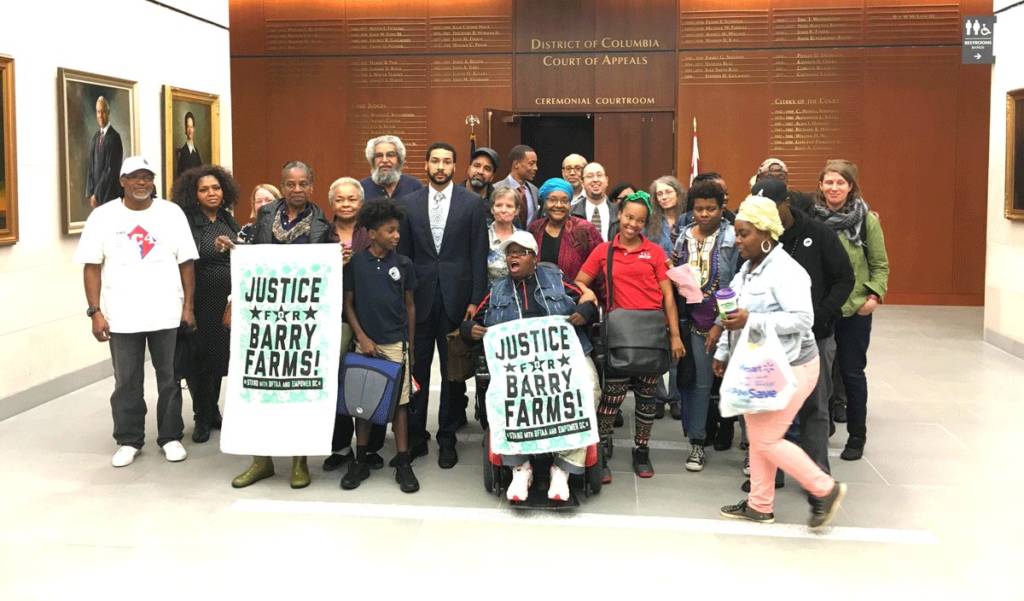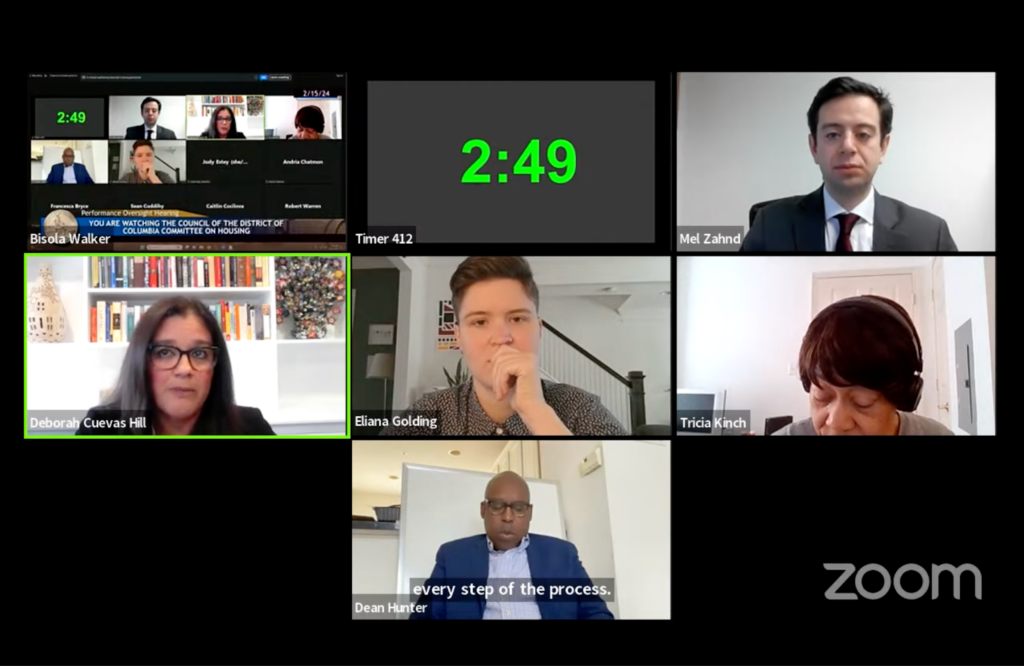Barry Farm, the District’s first all-Black community, formed after the Civil War and has existed in the same neighborly and supportive fashion since then. General Oliver Howard, known for Howard University, led the Freedmen’s Bureau to buy those 34 acres east of the Anacostia River and sell the individual lots to former slaves and free-born African-Americans. They, in turn, built their houses there with materials they also bought, according to a legal brief filed by attorney Ari Theresa on behalf of current Barry Farm Dwellings public housing residents.
In these 432 units of public housing, Barry Farm residents enjoy plenty of open space, including front and rear yards. The green space is often used for social gatherings and children play together in the open spaces. Residents garden, hold cook-outs and have neighborhood meetings in their backyards, the brief says.
The area is historically significant in the District and many neighbors there have shared ways of life, social networks and communal support for generations.
Since the community was established, the land has been zoned for low-density residential use. Buildings and density are evenly distributed, according to the brief. Now A&R Development intends to fill up that open space with proposed mixed retail and office space, in addition to a significant number of upscale apartments and some affordable housing units. Medium and high-density buildings would be clustered in one part of the site while overall project density is lowered by empty areas touted as park space or central open space.
The site was rezoned in 2014 from low-density residential to medium-mixed use, to include retail and residential uses.
A move to these high-density residential units would be uprooting public housing communities who relocated to them.
Before all this starts, every single Barry Farms resident must either be moved to other public housing or receive a housing voucher under the federal Uniform Relocation Act (URA), passed in 1970 and updated in 2005. While this is a federal requirement, one-to-one replacement is one of four guiding principles that the D.C. Housing Authority has stated repeatedly throughout this process and which they formally adopted in March of this year.
The Barry Farms Tenants and Allies Association (BFTAA), represented by Ari Theresa, argued the Zoning Commission illegally ignored the Barry Farm Park Chester Wade Road Community Revitalization Plan – referred to as The Small Area Plan — which was approved by D.C. Council in 2006, as well as ignored the District’s Comprehensive Plan, which BFTAA believes should have considered the displacement hardship the Barry residents would have to suffer.
In a December 2014 order, the Zoning Commission found that decision on displacement was outside their authority because it is a federal statute. “The Commission finds that neither the issue of displacement nor the issue of completing social impact studies is within its jurisdiction. However, the Commission finds that the PUD will appropriately provide housing for residents with a mix of incomes in compliance with the Comprehensive Plan, the Small Area Plan, and other District policies.” The decision goes on to say this ruling will be an improvement over “existing deteriorated physical conditions.”
The BFTAA argues strongly that the relocation and return support for residents the Commission also promises is at best very uncertain and probably non-existent
To the contrary, argued the BFTAA, the Commission is required under the District’s comprehensive plan to follow a policy that avoids “hardship” for residents, which under the law is within their discretion. The Barry Farm Small Area Plan calls for “avoidance of dislocation,” which Theresa’s brief argues the Zoning Commission violated when it found displacement was outside its jurisdiction.
The BFTAA appealed the Zoning Commission’s decision to the D.C. Court of Appeals, which was heard Sept. 28. They have collected 170 signatures on a petition to stop the development from proceeding, according to BFTAA officials.
Skyla Pondexter-Moore of Empower D.C. spoke into an amplified microphone to a rally of supporters outside the D.C. Court of Appeals building on 4th Street NW on a rainy morning before the oral arguments. “Dislocation is hardship,” she said into the microphone before asking listeners, “What would you do if this was your family?
“Gentrification is the new colonialism,” she continued, “and we’re not going for it. Stand against displacement. People over money; what happened to the people having the power?”
Pondexter-Moore claimed that 40,000 D.C. residents have been pushed out of their housing to date by gentrification, which matches demographic trends observed in the 2010 Census. At Barry Farm, roughly 400 families are being displaced. The Barry Farm group thinks the D.C. Housing Authority has neglected them, according to Pondexter-Moore.
Twenty-year Barry Farm resident and vice president of BFTAA Paulette Matthews grabbed the microphone to add, “Why should I have to ask the government whether I can stay in the same place where I was born and raised.”

A large crowd of BFTAA supporters gathered in the basement courtroom to hear the oral arguments.
“Once people are dispersed they lose the support systems that allow them to function and survive,” Brett Williams, an expert on poverty in urban areas, testified. Ms. Williams has a Ph.D. in Anthropology, and has written eight book chapters about gentrification, poverty and African-Americans in urban communities, according to Theresa’s brief. She has also published three peer-reviewed articles on the same subject.
“You don’t cope with poverty by being isolated; people share and pool resources. Emptying support systems in poor communities … is very misguided. Concentrated poverty is hurt, not helped, by dispersing people.”
BFTAA attorney Theresa argued to a three-judge panel that dislocation means hardship; for them it is forced removal from their homes. “As soon as you’ve told someone they must leave their home, it’s caused them hardship.”
A&R Development has agreed to do the construction in phases so that disruption to the community is minimal, a decision that was made years ago. A first phase has seen construction of about 100 replacement housing units near the original site under a “build first” program of building replacement units one-for-one so that displaced people can have a place to call home until they are able to find permanent new housing.
A&R attorney Kyrus Freeman argued that relocation is not the same thing as dislocation, and that the details of the relocation plans will be forthcoming later. But neither the Zoning Commission nor the developer had any idea when.
The plan calls for 1,400 residential units, of which 344 would be replacement public housing units. About 100 replacement units have been built, and some residents have been relocated. Freeman said there’s a statement of phase 2, but the final design hasn’t been funded yet. The replacement is supposed to be completely one-for-one.
Freeman said that helping the Barry Farm residents relocate is outside the Zoning Commission’s jurisdiction because it is a matter of federal law. He said all they could do is verify the planned “revitalization.” The planned redevelopment is part of the D.C. government’s plan for updating the area and demolishing such “distressed housing.”
Appeals court Judge Roy W. McLeese III commented that the Commission should go through a process to assess what would be lost by destroying the Barry Farms community and what redevelopment would gain; they are weighing the adverse impact of development as well as its benefits.
BFTAA attorney Theresa worried aloud that he doesn’t think the residents are going to be given another opportunity for input on the plan, especially because they’ve already started moving the families out. “You can’t just offer [further input] to a fraction of the residents,” he noted; “You have to offer it to everyone.”
Residents are worried about what happens to them while the project is being built, since there is no set timetable and what it will be like when they return, according to Theresa.
Williams said in her testimony that once residents are removed, “if there’s a problem with your lease, you won’t be able to come back. There won’t be enough affordable large units to enable people to come back and resume the community they’ve worked so hard to build.”
“[Uprooting] disrupts systems of community supports. It means we’re not taking care of our neighbors,” said Margaret Dwyer, a Ward 3 resident who came to the pre-appeal rally outside the courthouse out of citizen concern. “Why shouldn’t everybody be comfortable? This is a rich city.”
In the BFTAA, attorney Theresa stated that if D.C. wants to do a project they can; if they don’t, they can’t say it’s because they don’t have enough money. The city had over a billion dollars in surplus funding for FY2016.
A decision from the appeals court is anticipated within the next two months. BFTAA is asking the court for a remand back to the D.C. Zoning Commission. The group hopes the court will nullify the Zoning Commission’s ruling and make them go through an entirely new zoning process. At the very least, BFTAA seeks a modification to the order now standing to add basic amenities like preserving yard space for returning residents, according to Theresa.








